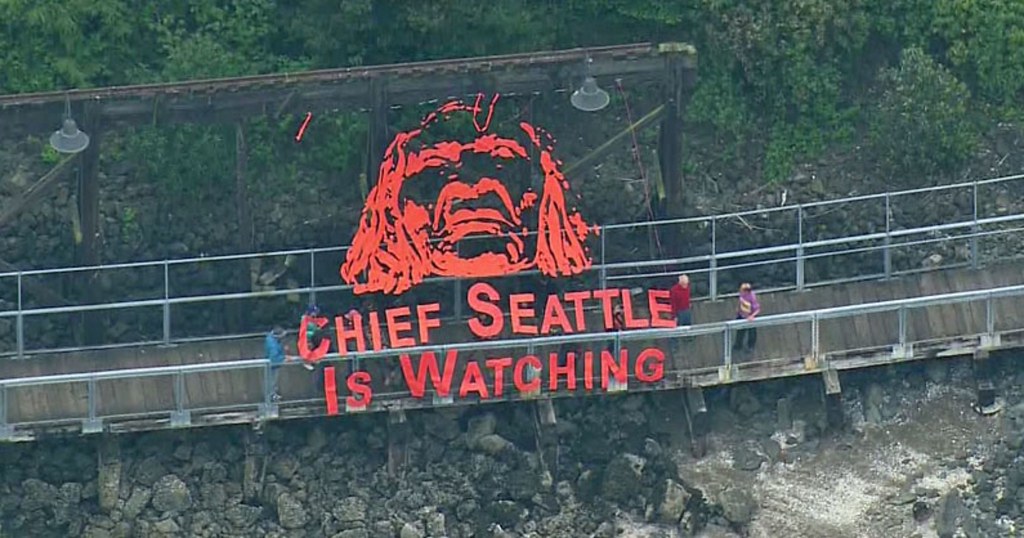
We’re going to start the post with a quick exercise. Where do you live and work? Easy enough, right? Some of you probably can name a street, neighborhood, town, city, or state off the top of your head.
Let’s take the first question and change a couple of words – whose land do you live and work on?
Some of you might already know whose land that you live and work on. For those who do not, you can visit https://native-land.ca/ to find more information about the indigenous lands you currently occupy.
As we wrap up Native American Heritage Month this week, we are taking some time to give some context around the land acknowledgment included in our recent talks. You can use the resources at the end of the post for your acknowledgments that go beyond a statement of whose land you’re on.
Acknowledgment as The First Step
LDH lives and works on the unceded, traditional land of the Duwamish People, the first people of Seattle.
The above-italicized sentence is the start of the land acknowledgment in recent LDH talks. Many of us have encountered similar statements in various events and presentations. Land (or territory) acknowledgments sometimes stop here, naming the peoples whose land we’re on. However, this approach lacks the full acknowledgment of how the land became occupied. It also doesn’t acknowledge the present-day impact this occupation has on the people.
The Duwamish Tribe was the first signatories on the Treaty of Point Elliott in 1855. The Tribe has been denied the rights established in the treaty for over 165 years. The United States Federal Government currently does not recognize the Duwamish Tribe, denying the Tribe the rights and protections of federal recognition.
Naming the treaty is important in giving the historical context around the occupation of the land, but equally important is the explicit statement that the treaty has still to be honored by the federal government. The Duwamish Tribe is not federally recognized, which is important to acknowledge because of its historical impact on the Tribe and its current impact on the Tribe’s rights to funding for and access to housing, social services, and education, among other resources and services.
The Duwamish People are still here, continuing to honor and bring to light their ancient heritage.
Indigenous people are still here. It’s easy to leave the land acknowledgment to acknowledge the past and not venture into the present. But an acknowledgment of the present has to go beyond education and head into action.
Calls to Action
A portion of the speaker’s fee from the conference will be donated to Real Rent Duwamish. Real Rent serves as a way for people occupying this land to provide financial compensation to the Tribe for use of their land and resources – https://www.realrentduwamish.org/
The Tribe has started a petition to send to our state congresspeople to create and support a bill in Congress that would grant the Tribe federal recognition. The link to the petition is on the slide – https://www.standwiththeduwamish.org/
You are welcome to join me in donating to Real Rent or signing the petition.
The second half of the acknowledgment are two specific calls to action. Each action provides the opportunity for event attendees to support or advocate for the Duwamish People whose land LDH occupies. Real Rent Duwamish provides financial support and resources for the Tribe through a voluntary land tax. The petition aims to gather support for a bill granting the Tribe federal recognition, giving the Tribe access to services and resources available to other treaty tribes. If attendees cannot financially donate to Real Rent, they can provide non-financial support through the petition.
LDH’s acknowledgment focuses on calls to action around solidarity with the Duwamish People. Other land acknowledgments make the additional call for event attendees to research whose lands they occupy through https://native-land.ca/. Clicking on a specific territory will provide a page with resources where attendees can learn more about the Indigenous people whose land they’re on. For example, the Duwamish Tribe page on the site also links to ways to support the Tribe. Other calls to action found in land acknowledgments include supporting water protectors, such as supporting water protectors in stopping Line 3.
Resources
The list below is some resources you can use to inform not only yourself and others about the land you occupy but also what you and others can do to be in solidarity with Indigenous people in your acknowledgments and beyond.
- A guide to Indigenous land acknowledgment
- Are you planning to do a Land Acknowledgement?
- Territory Acknowledgement
- Beyond territorial acknowledgments
- Land Reparations & Indigenous Solidarity Toolkit
- Rethinking Thanksgiving Toolkit
- Acknowledging the Land, Building Deeper Relationships (h/t to Sandy Littletree for the link!)
